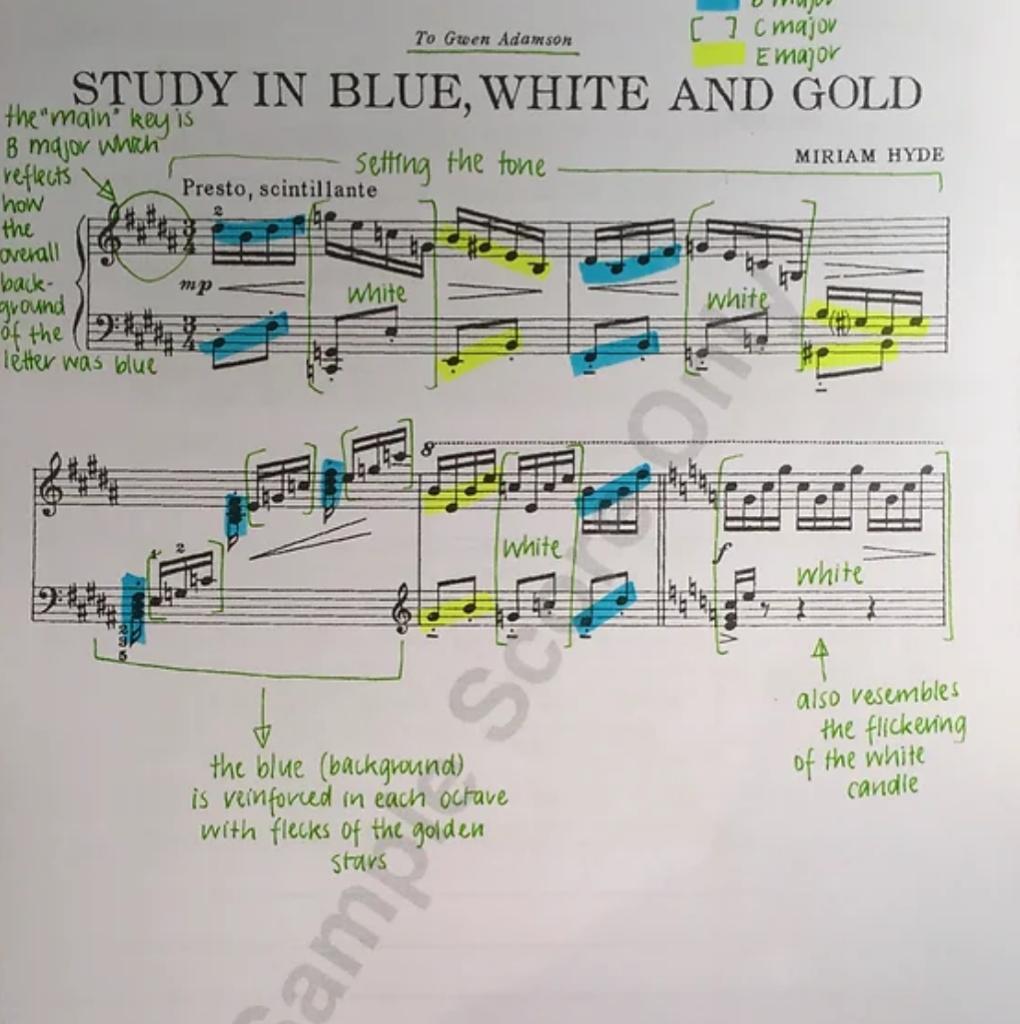“Miriam Hyde (1913-2005) … Australian composer, pianist and teacher with an impressionistic style … was a synaesthete who associated certain musical notes and keys with different colours. Because of this condition she composed many character pieces with very descriptive titles- such as “Dragonflies” (and) “Magpies at Sunrise”*

I’m really interested in Miriam Hyde, OBE, AO. To me, there’s a dilemma between the story of an engaging young virtuoso from Adelaide heading off to Royal College of Music (to be a student next to Benjamin Britten in composition and piano) and the more common pictures of an elderly examiner, linked for so many Australians (including acclaimed musicians) with ‘AMEB’ piano exams… Her legacy here is so focussed on her legendary dedicated teaching, exam compositions and adjudication, that people sometimes forget her amazing beginnings.
My intention through this Creative Arts Fellowship is to amplify early work of this interesting creative personality, and to read more about her documented (but little known) synaesthesia. It will help me to learn firsthand, some more about the colourful condition, as well as Miriam herself.
The Creative Arts Fellowship is a wonderful opportunity created by the Friends of the National Library of Australia. I’m going to spend July 2024 looking at some of Miriam Hyde’s undigitized papers in the archives of the National Library in Canberra. I’m focussing on her student time in London to illuminate the music (featuring unpublished Trio arrangements and her rarely performed 1933 Fantasy Trio), her neurodiversity, and the extraordinary achievements of a young professional female artist from Adelaide in 1930’s London society.
Like so many women, in Sydney Miriam eventually found a career path to fit in with the responsibilities of being a wife and mum. She continued her passion for music through supporting music examinations and competitions to build new generations and left a proud legacy for Australia. But how many people know she was a synesthete? Have a listen to her playing ‘Study in Blue, White and Gold’ (incidentally, she received injections into her hands here in order to reduce her pain on playing).
Synesthesia is a neurodiverse condition where at least one sense is linked to an involuntary experience associated with intense feelings, anxiety and intense hyper-focus (also useful for practice and high achievement.) It often exists in artists, who have often been musically immersed from a young age- while their brains are developing. (For example, I started on my fourth birthday and immersed in music ever since, so I suppose it’s not that surprising that I’ve had it since then).
The highly strung, virtuosic nineteen year old Miriam, setting sail for London while hoping to study with Vaughan Williams, experienced music, light, landscape and nature in an extreme way- all synesthetes do share an inner joy and an ‘excitable brain’. Her 166 letters home seem to be full of such enthusiasm and excitement that must have impressed many people in London at the Royal College of Music, where she was funded by the prestigious and historic Elder Overseas Scholarship that historically links Adelaide with London.
Despite being alongside the pianist and composer Benjamin Britten, this young South Australian was soon being offered some major opportunities playing solo with top orchestras and conductors, including performing her own compositions. Miriam must have been such a virtuoso, with her excitable brain, and the toll of all this practicing and composing probably added up to many late nights! She eventually suffered a nervous collapse- something also quite common in neurodiverse people- I think this could be an intense read.
Through looking at her handwriting, both musical and written, I will get to see her mind working; working out her practise and composing, describing her love of nature, her excitement on playing with the London Philharmonic, and thoughts on meeting Rachmaninov. There are many letters and manuscripts already digitized, but Fellowship will allow me access to new material not yet easily available, and to see her own handwritings and manuscripts.
Our distinguished pianist in Tarrawatta Trio, Michael Ierace, won the same triannual Elder Overseas Scholarship to RCM and further awards in London. With similar stories, our cello colleague Tom Marlin, Guildhall School of Music and Yong Sieu Toh Conservatory Singapore, and myself Royal Academy of Music; it’s easy for us to understand how stimulating it must have been for the young Miriam to suddenly be in a new musical environment away from home, and how immense these London concert opportunities were. We’ve all known how exciting it is to be surrounded by motivated and talented people in awe-inspiring historic buildings. The sound of many people practising in beautiful acoustics at Royal College of Music must have been so colourful!
Hyde’s unpublished Trio arrangements, which thanks to Michael Ierace’s research we have already begun to play, were actually dedicated to ‘The Cecilian Trio.’ Who were the mysterious Cecilian Trio? Is their name a dedication to Patron Saint of Music?
Miriam set at least two traditional songs for this Trio. Her setting of traditional music was in common with her Adelaide contact Percy Grainger and her London friend Benjamin Britten. So, I’m just wondering is it a coincidence that Cecil Sharp, founder of English Folk Song and Dance Society, held a short but important part in the musical life of Adelaide and was well known to Grainger’s father. Will she be aware of, or mention this?
And did she write about fellow student Benjamin Britten, in her letters? I’ll also see the manuscript of her autobiography where she herself re-examined her time in London.
I can’t wait to make a start, with background research in the University of Adelaide Special Collections and hoping to be able to visit the Royal College of Music archives while I’m teaching at Royal Academy of Music next month.
I am really looking forward to examining her legacy for Australia and painting a picture of this unique and interesting person who never stopped being enthralled by her feelings for nature and music. Here she is writing in 1975 (after recording her own Piano Concerti in Perth, at age 62):
“…in these precious days I’ve known a world
Which but a few are called upon to share;
A world of agony and ecstasy
That only a musician feels at heart;
The plaintive oboe solo and the rise
Of cello phrases on the higher strings;
The notes of doom that throb from timpani,
The surge of brass, the vibrant violins,
And piano chords that mount to climaxes
In which one feels possessed, engulfed by sound.
Strange, as one contemplates the scope of such
A universe, so ordered and sublime,
That it should be so hard, and mean so much,
To give one quaver its due point in time…”
Miriam Hyde South Australian Creative Writers – Women Writers database 2004
State Library of South Australia – collaborative database with Flinders University
*(Wikipedia, 2015e) Chelsea Hudson, https://15hudsoc.wixsite.com/synaesthesia/miriam-hyde








